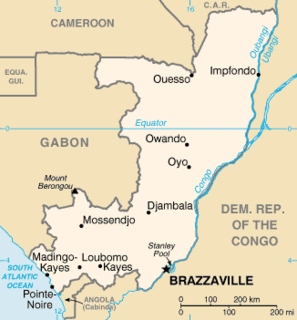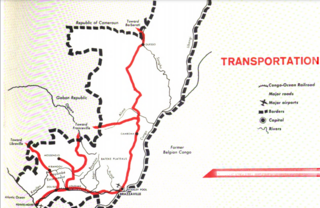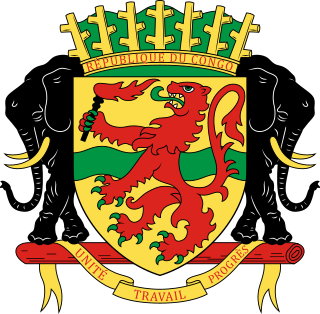Related Research Articles

The Republic of the Congo is located in the western part of central Africa. Situated on the Equator, it is bordered by the Angolan exclave of Cabinda to the south (231 km), the Democratic Republic of the Congo to the north and west (1,229 km), the Central African Republic (487 km) and Cameroon (494 km) to the north and Gabon to the west (2,567 km). Congo has a 169 km long Atlantic coast with several important ports. The Republic of the Congo covers an area of 342,000 km², of which 341,500 km² is land while 500 km² is water. Congo claims 200 nautical miles (370 km) of territorial sea.

Transport in the Republic of Congo includes land, air and water modes. Over 1,000 km (620 mi) of paved roads are available. The two international airports are Maya-Maya Airport and Pointe Noire Airport.

Marien Ngouabi was the third President of the Republic of the Congo from January 1, 1969, to March 18, 1977.

Brazzaville is the capital and largest city of the Republic of the Congo. Constituting the financial and administrative centre of the country, it is located on the north side of the Congo River, opposite Kinshasa, the capital city of the Democratic Republic of the Congo.

Pointe-Noire is the second largest city in the Republic of the Congo, following the capital of Brazzaville, and an autonomous department since 2004. Before this date it was the capital of the Kouilou region. It is situated on a headland between Pointe-Noire Bay and the Atlantic Ocean. Pointe-Noire is the main commercial centre of the country and has a population of 715,334 (2007), expanding to well over 1 million when the entire metropolitan area is taken into account.

The Catholic Church in the Republic of Congo is part of the worldwide Catholic Church, under the spiritual leadership of the Pope in Rome.

The Departments of the Republic of the Congo are divided into 86 districts and 6 communes; which are further subdivided into urban communities and rural communities ; which are further subdivided into quarters or neighborhoods (quartiers) and villages. Note the departments of Brazzaville and Pointe-Noire are made of 1 commune each, then divided in urban districts (arrondissements).
The Republic of the Congo is divided into 12 départements (départements). Departments are divided into communes and/or districts; which are further subdivided into urban communities and rural communities ; which are further subdivided into quarters or neighborhoods (quartiers) and villages.

Presidential elections were held in the Republic of the Congo in August 1992, marking the end of the transitional period that began with the February–June 1991 National Conference. It was won by Pascal Lissouba of the Pan-African Union for Social Democracy (UPADS), who defeated Bernard Kolélas of the Congolese Movement for Democracy and Integral Development (MCDDI) in a second round of voting.

An indirect Senate election was held in the Republic of the Congo on 5 August 2008. 42 of the 72 seats in the Senate were at stake in this election, with six elected from each of seven departments. The Senate was expanded by six members at the time of this election to account for the creation of Pointe-Noire Department. The senators were elected by councillors who were in turn elected in local elections on June 29, 2008. A presidential decree on July 24, 2008, stated that an electoral college to elect senators from seven departments—Pointe-Noire, Niari, Lekoumou, Pool, Plateaux, Cuvette West, and Likouala—would meet on August 5. In the election, there were a total of 133 candidates across the six departments where the election was being held. 33 candidates of the Rally of the Presidential Majority (RMP), which supports President Denis Sassou Nguesso, were elected to the Senate, in addition to seven independent candidates and two candidates of the opposition Pan-African Union for Social Democracy (UPADS).

The Republic of the Congo, also known as Congo-Brazzaville, the Congo Republic or simply either Congo or the Congo, is a country located in the western coast of Central Africa. The country is bordered to the west by Gabon, to its northwest by Cameroon and its northeast by the Central African Republic, to the southeast by the DR Congo, to its south by the Angolan exclave of Cabinda and to its southwest by the Atlantic Ocean. French is the official language of the Republic of the Congo.

Health in Angola is rated among the worst in the world.
Benin faces a number of population health challenges. Apart from modern medicine, traditional medicine plays a big role too.

Health in the Central African Republic has been degraded by years of internal conflict and economic turmoil since independence from France in 1960. One sixth of its population is in need of acute medical care. Endemic diseases also put a hide demand on the health infrastructure, which requires outside assistance to sustain itself.
Health in Equatorial Guinea.

The Republic of the Congo includes six communes, divided in urban districts (arrondissements). Two of these communes, Brazzaville and Pointe-Noire, are also a department:
The official language of the Republic of Congo is French. Other languages are mainly Bantu languages, and the two national languages in the country are Kituba and Lingala, followed by Kongo languages, Téké languages, and more than forty other languages, including languages spoken by Pygmies, which are not Bantu languages.
References
- 1 2 "The World Factbook, Republic of the Congo". CIA. Retrieved January 9, 2021.
- ↑ "Human Rights Measurement Initiative – The first global initiative to track the human rights performance of countries". humanrightsmeasurement.org. Retrieved 2022-03-17.
- ↑ "Congo (Rep.) - HRMI Rights Tracker". rightstracker.org. Retrieved 2022-03-17.
- ↑ "Congo (Rep.) - HRMI Rights Tracker". rightstracker.org. Retrieved 2022-03-17.
- ↑ "Congo (Rep.) - HRMI Rights Tracker". rightstracker.org. Retrieved 2022-03-17.
- ↑ "Congo (Rep.) - HRMI Rights Tracker". rightstracker.org. Retrieved 2022-03-17.
- 1 2 3 4 "Human Development Report 2009". Archived from the original on January 17, 2010. Retrieved 2014-06-24.. undp.org
- 1 2 3 4 5 6 7 8 9 10 11 12 13 14 15 16 17 18 19 20 21 22 23 24 25 26 27 "A spatial database of health facilities managed by the public health sector in sub-Saharan Africa". World Health Organization. February 11, 2019. Archived from the original on April 22, 2019. Retrieved May 8, 2020.
- ↑ Google maps data and other sources listed for each hospital
- 1 2 "Hospitals in Brazzaville". Allianz Worldwide Care. Retrieved January 9, 2021.
- ↑ "Hospital 31 July D'Owando". Africa Bizinfo. Retrieved January 9, 2021.
- ↑ "Regional Military Hospital". Med Pages. Retrieved January 9, 2021.
- ↑ "Pioneer Christian Hospital". Congo Hospital. Retrieved January 9, 2021.
- ↑ "University Hospital Brazzaville". ENIA France. Retrieved January 9, 2021.
- 1 2 "African Leaders Malaria Alliance"
- ↑ Country Comparison :: HIV/AIDS – adult prevalence rate. CIA – The World Factbook. Cia.gov. Retrieved on February 25, 2013.